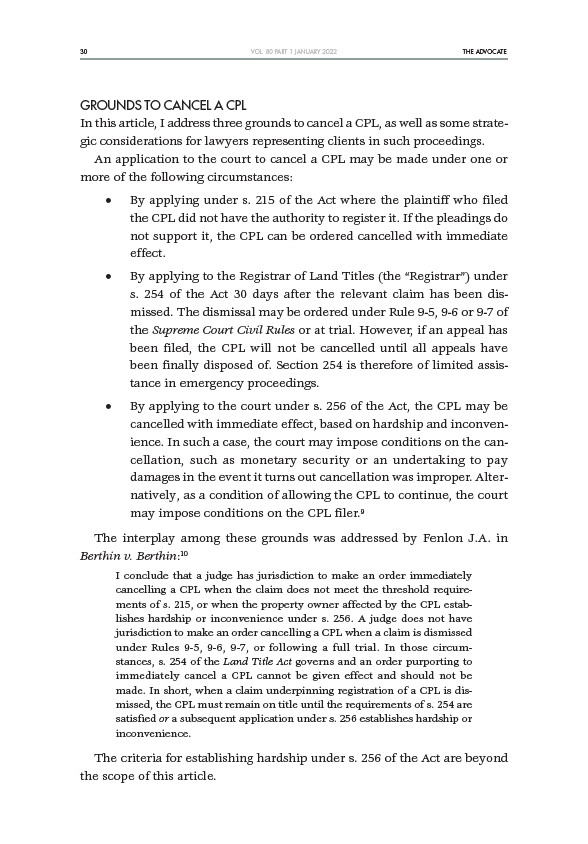
30 THE ADVOCATE
VOL. 80 PART 1 JANUARY 2022
GROUNDS TO CANCEL A CPL
In this article, I address three grounds to cancel a CPL, as well as some strategic
considerations for lawyers representing clients in such proceedings.
An application to the court to cancel a CPL may be made under one or
more of the following circumstances:
• By applying under s. 215 of the Act where the plaintiff who filed
the CPL did not have the authority to register it. If the pleadings do
not support it, the CPL can be ordered cancelled with immediate
effect.
• By applying to the Registrar of Land Titles (the “Registrar”) under
s. 254 of the Act 30 days after the relevant claim has been dismissed.
The dismissal may be ordered under Rule 9-5, 9-6 or 9-7 of
the Supreme Court Civil Rules or at trial. However, if an appeal has
been filed, the CPL will not be cancelled until all appeals have
been finally disposed of. Section 254 is therefore of limited assistance
in emergency proceedings.
• By applying to the court under s. 256 of the Act, the CPL may be
cancelled with immediate effect, based on hardship and inconvenience.
In such a case, the court may impose conditions on the cancellation,
such as monetary security or an undertaking to pay
damages in the event it turns out cancellation was improper. Alternatively,
as a condition of allowing the CPL to continue, the court
may impose conditions on the CPL filer.9
The interplay among these grounds was addressed by Fenlon J.A. in
Berthin v. Berthin:10
I conclude that a judge has jurisdiction to make an order immediately
cancelling a CPL when the claim does not meet the threshold requirements
of s. 215, or when the property owner affected by the CPL establishes
hardship or inconvenience under s. 256. A judge does not have
jurisdiction to make an order cancelling a CPL when a claim is dismissed
under Rules 9-5, 9-6, 9-7, or following a full trial. In those circumstances,
s. 254 of the Land Title Act governs and an order purporting to
immediately cancel a CPL cannot be given effect and should not be
made. In short, when a claim underpinning registration of a CPL is dismissed,
the CPL must remain on title until the requirements of s. 254 are
satisfied or a subsequent application under s. 256 establishes hardship or
inconvenience.
The criteria for establishing hardship under s. 256 of the Act are beyond
the scope of this article.